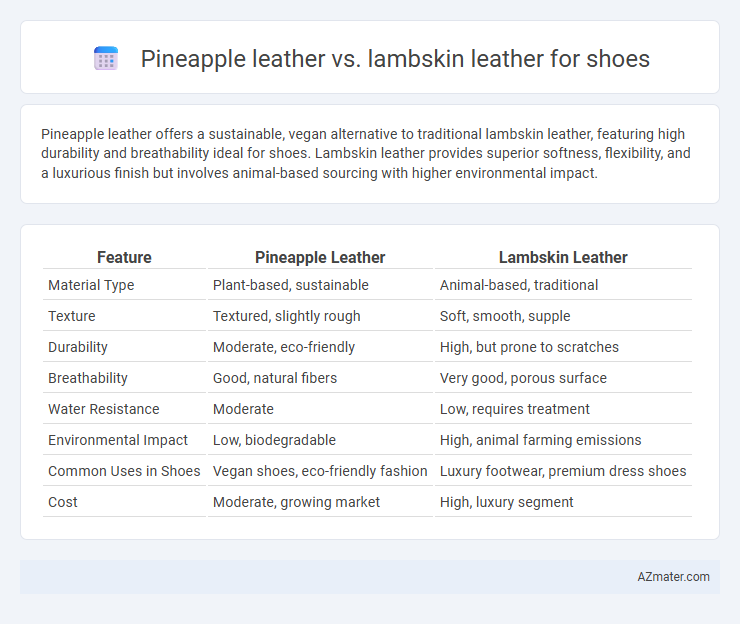Pineapple leather offers a sustainable, vegan alternative to traditional lambskin leather, featuring high durability and breathability ideal for shoes. Lambskin leather provides superior softness, flexibility, and a luxurious finish but involves animal-based sourcing with higher environmental impact.
Table of Comparison
| Feature | Pineapple Leather | Lambskin Leather |
|---|---|---|
| Material Type | Plant-based, sustainable | Animal-based, traditional |
| Texture | Textured, slightly rough | Soft, smooth, supple |
| Durability | Moderate, eco-friendly | High, but prone to scratches |
| Breathability | Good, natural fibers | Very good, porous surface |
| Water Resistance | Moderate | Low, requires treatment |
| Environmental Impact | Low, biodegradable | High, animal farming emissions |
| Common Uses in Shoes | Vegan shoes, eco-friendly fashion | Luxury footwear, premium dress shoes |
| Cost | Moderate, growing market | High, luxury segment |
Introduction to Pineapple Leather and Lambskin Leather
Pineapple leather, also known as Pinatex, is an innovative sustainable material made from the fibers of pineapple leaves, offering a cruelty-free and eco-friendly alternative to traditional leathers. Lambskin leather is a premium natural material prized for its softness, smooth texture, and durability, often used in high-end footwear for its luxurious feel. Both materials provide distinct advantages, with pineapple leather emphasizing ethical production and environmental benefits, while lambskin leather stands out for its classic elegance and comfort.
Origins and Production Processes
Pineapple leather, also known as Pinatex, originates from the fiber extracted from pineapple leaves primarily in the Philippines, utilizing sustainable and agricultural byproduct materials. Lambskin leather is derived from the hides of young sheep, processed through traditional tanning methods involving chemical or vegetable tanning to create a soft, luxurious texture. Pineapple leather production emphasizes eco-friendly practices with minimal chemical use, whereas lambskin leather manufacturing entails intensive resource consumption and animal sourcing.
Environmental Impact Comparison
Pineapple leather, derived from agricultural waste such as pineapple leaves, offers a sustainable alternative to lambskin leather by significantly reducing resource consumption and landfill waste. Lambskin leather production involves intensive water use, chemical tanning processes, and greenhouse gas emissions from livestock farming, contributing to environmental degradation. Choosing pineapple leather for shoes supports lower carbon footprints and promotes circular economy principles, making it a more eco-friendly option compared to traditional lambskin.
Durability and Longevity
Pineapple leather, made from pineapple leaf fibers, offers a sustainable alternative with good durability but generally falls short of lambskin leather's strength and long-term wear resistance. Lambskin leather, prized for its softness and flexibility, provides superior durability and maintains structural integrity over extended use, making it ideal for high-quality, long-lasting shoes. While pineapple leather is water-resistant and eco-friendly, lambskin leather remains unmatched in resilience and longevity under frequent wear conditions.
Comfort and Breathability
Pineapple leather, derived from Pinatex, offers superior breathability due to its natural fiber composition, making it highly comfortable for extended wear. Lambskin leather provides a soft, supple feel that conforms to the foot but tends to retain heat and moisture more, reducing overall breathability. For shoes prioritizing ventilation and moisture-wicking, pineapple leather is often the preferred sustainable choice, whereas lambskin excels in softness and traditional luxury.
Aesthetic and Texture Differences
Pineapple leather exhibits a unique, fibrous texture with a slightly rough surface that offers a distinctive, eco-friendly look compared to Lambskin leather's smooth, supple, and glossy finish prized for luxury shoes. Lambskin leather delivers a rich, buttery feel that molds closely to the foot, providing an elegant and refined aesthetic, whereas pineapple leather often displays subtle natural patterns and a matte appearance, emphasizing sustainability and originality. The tactile contrast between the two materials highlights pineapple leather's lightweight, breathable nature versus Lambskin's soft, durable, and premium smoothness favored in high-end footwear.
Maintenance and Care Requirements
Pineapple leather requires minimal maintenance, needing only occasional wiping with a damp cloth and avoiding prolonged sun exposure to prevent discoloration, while it is naturally resistant to stains and water damage. Lambskin leather demands more intensive care, including regular conditioning to maintain its softness and prevent cracking, as well as protection from moisture to avoid permanent damage. Both materials benefit from storage in breathable bags, but lambskin's delicate texture necessitates extra caution to preserve its luxurious feel and appearance.
Price and Accessibility
Pineapple leather, made from renewable pineapple leaf fibers, offers a vegan and sustainable alternative to traditional lambskin leather, often priced lower due to its synthetic production process and emerging market presence. Lambskin leather, sourced from sheep hides, commands higher prices because of its natural softness, durability, and established luxury reputation, but it tends to have limited accessibility due to ethical concerns and supply constraints. Consumers seeking affordable, eco-friendly shoes may prefer pineapple leather options, while those prioritizing premium quality and exclusivity typically opt for lambskin leather.
Ethical and Vegan Considerations
Pineapple leather, derived from Pinatex made using pineapple leaf fibers, offers an eco-friendly and sustainable alternative to traditional lambskin leather, addressing ethical concerns related to animal cruelty and environmental impact. Lambskin leather, sourced from the skins of lambs, raises significant ethical issues due to animal harm and the carbon footprint associated with livestock farming. Consumers seeking vegan and cruelty-free footwear increasingly prefer pineapple leather for its plant-based origins and minimal ecological footprint.
Choosing the Right Leather for Your Shoes
Pineapple leather offers a sustainable alternative to traditional materials with its eco-friendly production from pineapple leaf fibers, providing durability and breathability suitable for casual shoes. Lambskin leather is prized for its ultra-soft texture and luxurious finish, ideal for formal footwear requiring smoothness and flexibility. When choosing the right leather for your shoes, prioritize pineapple leather for vegan options and sustainability, while lambskin excels in elegance and comfort for high-end styles.

Infographic: Pineapple leather vs Lambskin leather for Shoe
 azmater.com
azmater.com